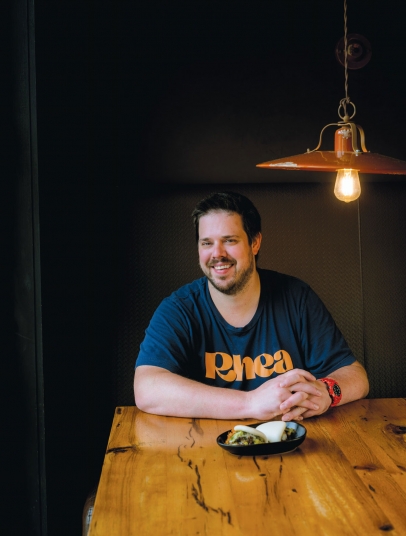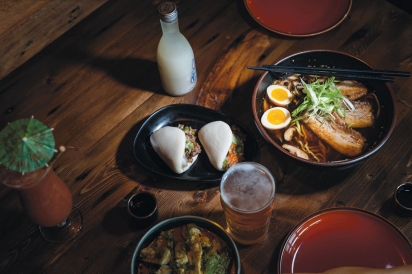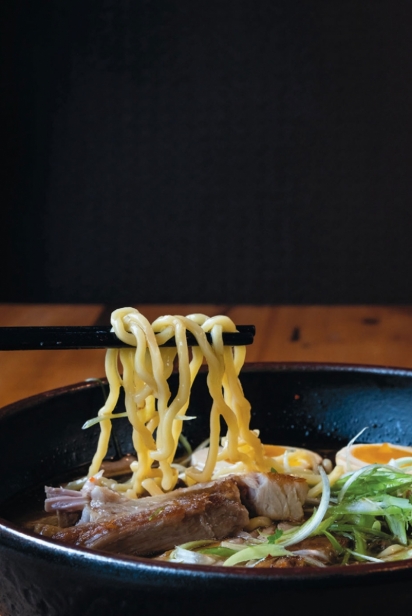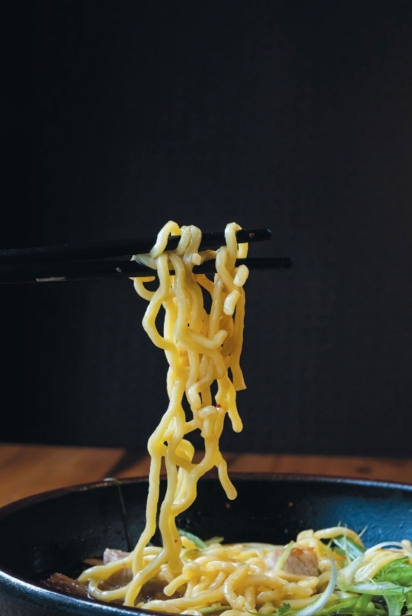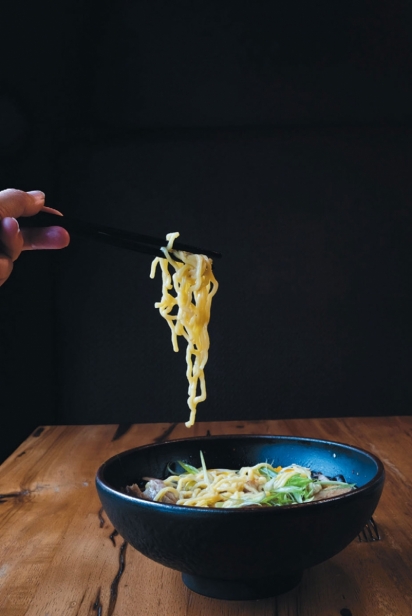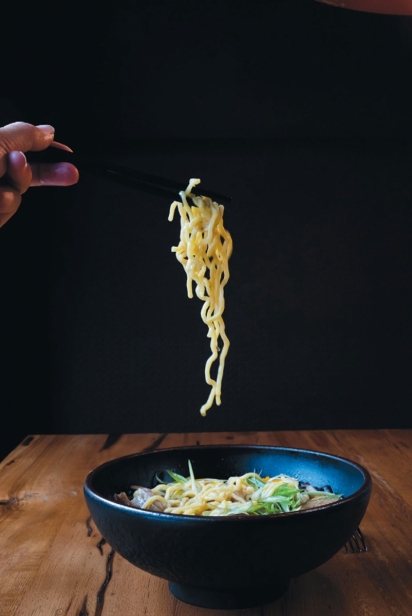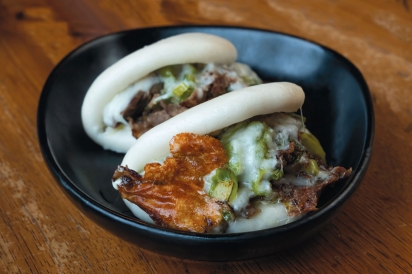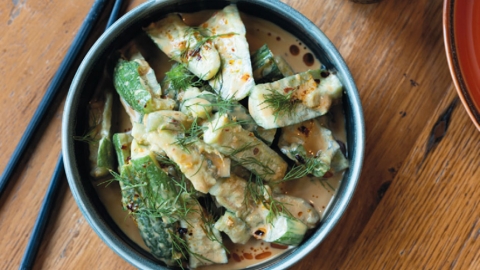Rhea Is Making Food Fun Again
When I was a kid, food was as much about playing as it was eating.
Molding my mashed potatoes into a volcano spewing butter and gravy, perfecting the spaghetti twirl with a wrist flourished just so. My nutritional needs were (generally) met, I’d pushed boundaries enough to earn eye rolls but not punishment from my parents, and most importantly—I left the table feeling full of food but also joy.
At some point, my relationship with food evolved. You reach a certain point in life when, sadly, no one is impressed when you turn mashed potatoes into a volcano, and the entire enterprise loses its luster. Add to that the wider culture’s broad come-to-Jesus moments over the role of agriculture in climate change, the dangers of food and water shortages threatening billions across the globe, the pressing issues of cultural appropriation in every arena of life (including food) and the need for authenticity.
Food became deadly serious.
But can a sense of fun and an earnest dedication to responsible food choices and honoring cultures that grew and inspired foods and dishes still end up on the plate together? Or are they mutually exclusive? At Rhea, the team walks the line between joy and solemnity with more grace than I’ve seen in years.
From Pop-up to Brick and Mortar
Rhea began as a pop-up at Seneca, chef de cuisine Peter Hahm explains. And in many ways, that initial sense of experimentation and quick-fast hustle-bustle is still part of Rhea’s DNA.
It is the second project introduced in Saratoga Springs by culinary power couple Mike and Michelle Spain. They both attended the vaunted Culinary Institute of America together and rose through the ranks as line cooks and executive chefs at Sperry’s, Prime at Saratoga National, Druther’s Brewing Company, meeting the back- and front-of-house teams that would eventually come help them open first Seneca on Division Street in 2019, and then Rhea in 2022.
“I have known Mike and Shelley for years professionally, but more importantly, as my closest friends,” Hahm says. “Mike and I were inspired by David Chang’s work since the early 2000s, and we used to take special trips to New York City just to try his food and learn new techniques. But we don’t have a background in Asian cuisine beyond our obsession with it.”
The first iteration of Rhea—at Seneca in the form of special popups—served classically prepared Asian dishes that became so insanely popular, the Spains realized it deserved its own permanent brick-and-mortar. When a storefront on Broadway became available, they snapped it up.
Hahm, then executive chef at Druther’s, swooped in to help his old friends when the chef they were set to hire had a severe health setback.
“Originally, it was only going to be temporary,” Hahm says. “I would help them set up the kitchen, research and develop recipes and help train staff. But the more we worked on recipes, and the more we built out the space, it just became clear that I was the right fit for them, and Rhea was the right fit for me. We wanted the same things on both the menu and in the vibe.”
They wanted it to be authentic, but on their terms. And they wanted the food and atmosphere to feel inclusive and fun, he adds.
Authentically Inauthentic
Part of Rhea’s charm is the team’s lack of pretension.
“We are trying to be authentic with Asian cuisine,” Hahm says. “We have been very careful from the beginning to be clear that we use Asia in a very general sense as our baseline. A musician may use jazz as their baseline, and an artist may use abstraction as theirs. But obviously it is just a baseline and there’s a lot of room to maneuver.”
Asia, to be fair, covers a lot of ground all on its own. It consists of 48 countries and encompasses 19.2 million square miles, or about 30% of Earth’s habitable land. The food and cultures within Asia are diverse, too: Think of the wildly different dishes and cultures pinging around Afghanistan, Armenia, India, China, Laos, Pakistan, Japan, Turkey, Vietnam. Add to that both Hahm and the Spains’ range of inspirations and references, and the dinner possibilities are endless.
The structure of most kitchens is strictly hierarchical, but the operation at Rhea feels more horizontal. While the Spains, as owners, are clearly in charge, Hahm just as clearly has creative and executive power. And Hahm, in turn, seeks inspiration and feedback from his team.
“About 50% of our menu is locked in place, but the rest we reconsider and rotate out seasonally,” Hahm explains. “And when we’re working on creating new dishes, we take inspiration from our own lives and experiences and interests but also [that of ] the staff in the kitchen, who have a strong Mexican influence.”
Fusion cuisine often gets a bad rap, and while that isn’t precisely what Rhea is serving up—it’s the most apt generalization.
“The difference is, we don’t stick to just two cuisines,” Hahm says. “It goes back to Asia being our baseline, but we have influences from foods and dishes typically made all over the United States, in New England, Mexico, Italy and other places.”
Next to Asia-writ-large mainstays like Shanghai scallion noodles, you have teriyaki glazed meatballs, with gochujang creamed corn, toasted coconut, sesame seeds and scallions.
“We get guests here who have spent a lot of time eating noodles or ramen in Japan and China,” Hahm says. “And it’s led to some really interesting conversations, because they can see the roots of traditional ramen in the way we make our broth, and our general recipes, but then they see where we veer into totally new territory.”
Alongside the classic pork belly ramen with a cured egg, shiitake mushrooms and scallions, there are other options like the birria, with braised short rib, ancho chili broth, red onions, sliced jalapeños, cilantro, radish and cheesy tortilla.
But the dish that serves as the best edible example of their raison d’être is the buttermilk fried clam roll.
“My fiancé and I have spent the last few summers taking vacations to Maine with our kids,” Hahm says. “It’s all about the lobster rolls and the clam rolls. It’s such a delicious New England classic—but we wanted to give it an Asian twist.”
They began experimenting, and got most of the details right: good-sized clams, marinated in buttermilk and fried to perfection; a Japanese tartar sauce made with Kewpie mayo and miso-cured eggs; romaine lettuce; kimchi powder. The issue was the buns.
“We love working with Sookyung Lee, who runs Ppang Bakery in Schenectady,” Hahm says. “She already made this incredible Japanese milkbread for us that is basically white bread on steroids, cloudy, delicate and just slightly sweet. We decided we wanted her to create a new bun for us.”
It led to several Goldilocks conversations—bigger, fluffier, but not that big and fluffy—until they hit the perfect note.
“We love that custom bun she makes,” Hahm says. “It’s delicious and it perfectly marries Asian flavors and techniques with our own lives and experiences here. It may not make sense on paper, but that’s Rhea. Trying to define it is like trying to nail Jell-O to the wall.”
Plates Made for Sharing
The whimsical, inclusive approach to recipe development can be felt in the dining room as well. There are just over 100 seats, including the 30 deliciously comfy ones around the enormous U-shaped bar that anchors the room, the capacious booths that surround the bar and the handful of patio tables.
The dark wood paneling and dozens of thriving hanging and wall plants, the rock-driven but not obnoxiously loud soundtrack and the friendly servers and bartenders come together to give a “We’re ok, you’re ok, come sit over here vibe” that feels equally welcoming to single diners who want a great cocktail and dumplings on a random Wednesday, to Skidmore students out for a fun night on the town, groups of colleagues, families who dare to dine at places without dumbed-down kids’ menus, and couples.
“We really want everyone to feel like they can come, hang out and share,” Hahm says. “For years, Mike, Shelley and I have been going out to dinner and ordering multiple plates together. We always liked to share everything and that’s how they built the initial menu. It was my job to expand on that.”
Hahm also personally tries to come out and hang with guests for a bit when he isn’t slammed in the kitchen.
“During the week, I often run out dishes myself so I can check in with folks,” Hahm says. “We have a lot of regulars, and there are a lot of little things that our staff and regulars do, like saving our dipping sauce from dumplings to drizzle over our ramen. It’s called a ‘pro move’ when you combine elements from different plates to taste new combinations. We love sharing and trading intel, and I love hearing what they like and what inspires them, because sometimes it leads to new menu ideas.”
The team is also not at all possessive about recipes.
“I know a lot of chefs see their recipes as proprietary, but we don’t,” Hahm says. “I know how much labor, how many ingredients, how much overhead and attention to detail goes into every dish. If a customer asks for a recipe, I share it. And they often reach out and tell me how it worked out for them, and what they learned. Which, in turn, helps me.”
A sense of generosity makes Rhea more delicious, from the moment you walk in, to your last slurp of ramen. When chefs and bartenders play with your food and drinks, it feels like mom and dad are winking at you. Go ahead: it’s okay to not just relish the flavors and presentation—you can actually have a good time here.
Because Rhea is good at sharing, Hahm is sending us his recipe for Smashed Cucumber Salad. Find it on page 5.


